Our Tallow Balm Recipe
A pictorial tutorial
We didn't invent the idea of making skin balm out of tallow. We just re-discovered it, popularized it with our article in the Winter 2012 edition of the Wise Traditions Journal, and invented the term "tallow balm". If you're the do-it-yourself type, you may prefer to make your own tallow balm. We encourage it! The fewer people putting those chemical lotions on their skin, the better! If you decide that do-it-yourself isn't your cup of tea, we would, of course, be happy to make Tallow Balm for you.
Our process for making Tallow Balm is more complex than the tallow balm recipe shown below, which is one reason our balm is so soft and spreadable. We left out some of the more difficult steps so that you can make tallow balm in your own kitchen!
Step 1
Obtain tallow from pasture-raised animals (cows or sheep) that are 100% grass-fed. You can obtain tallow from your local farm or obtain the interior fat (suet) and render the tallow yourself. If you are buying tallow, make sure that it is not refined and that it is made from the suet (or interior fat) which is attached to the kidneys rather than from scraps or other fat. Refining it to remove the scent (or for whatever reason) makes it no longer a whole food and adversely affects its therapeutic benefit.
Begin here if you are rendering your own tallow from suet. Skip to Step 5 if you are using already rendered tallow.
The exact same method you use to render lard can be used to render tallow. There are different ways to render, but we recommend this "secret", superior, and easy method that works for both tallow and lard and doesn't use water (i.e., not the "wet" method), ensuring that the tallow will not undergo oxidation or rancidity:
Cut up the suet into small pieces as shown, excluding anything that isn't white. Place it in a vegetable steamer, colander, or pasta strainer over a pot, and put the pot in the oven at 220°F (105°C).
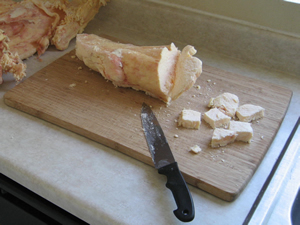 Cut suet up. |
 Put the suet in a colander. |
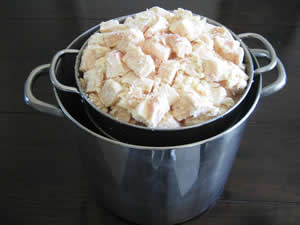 Put the colander over a pot. |
 Put the pot in the oven at 220°F (105°C). |
Step 2
Leave the pot in the oven until all of the tallow has melted out of the suet, mashing and stirring a few times during the process. The tallow will drip out into the pot. (The amount shown above, about 8 pounds or 4 kilograms, takes 12 - 18 hours to render and produces about a gallon.)
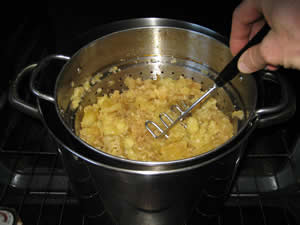 Mash and stir the suet occasionally. |
Step 3
Filter the liquid tallow that is in the pot, placing a (preferably organic) cloth in a new colander over a new pot and pouring the tallow through the cloth. Don't refine or try to "filter out" the tallow smell with methods that are often called triple-rendering or triple-filtering. This is important because the more a product is refined, the less therapeutic it is.
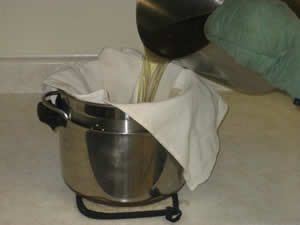 |
 |
| Pour the liquid tallow through a cloth-lined colander into a pot. | |
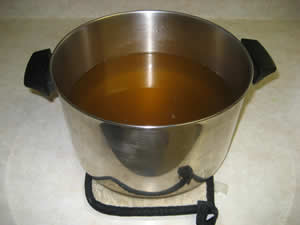 Voilà! Golden liquid tallow! |
Step 4 (optional)
If you are setting some or all of the tallow aside to make into balm later, you can pour it into jars and let it cool and solidify. Pure tallow can be kept for extended periods without the need for refrigeration.
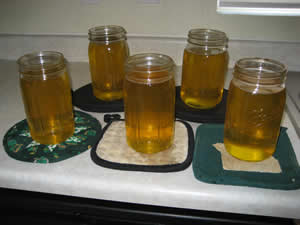 To set tallow aside, pour it into jars... |
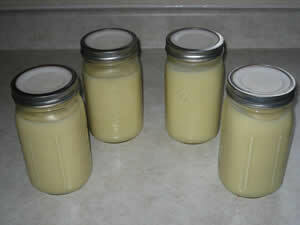 ...and let the tallow cool and solidify. |
Step 5
If you are starting with solid tallow, rendered at the farm or previously by yourself, melt it gently in the oven at 120 to 150°F (49 to 56°C).
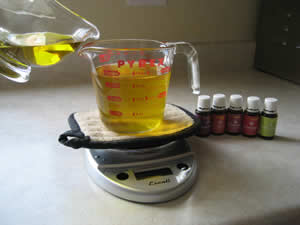
Add organic extra virgin olive oil
(or other ingredient(s))
to the liquid tallow to make balm.
With the tallow in the liquid state but as cool as possible (around 120°F or 49°C), thoroughly mix in the other pure, natural ingredient(s) of your choice to make the tallow softer and more spreadable at room temperature. (Pure tallow has a hard, waxy consistency; candles used to be made from tallow.) Put the mixture in the refrigerator and let it solidify. This gives the tallow balm a smoother consistency than letting it solidify at room temperature. (We use our own secret process to make our tallow balm even softer, smoother, and easier to use.)
The amount of the other ingredient(s) that you mix with the tallow will depend on the ingredient and the degree of spreadability you are looking for. We use extra virgin olive oil. Olive oil has been considered a healing salve for the skin since ancient times due to its soothing, cleansing, and moisturizing properties. Olive oil is liquid at room temperature, so not much is needed to soften the tallow. If you use a product that is more solid, such as coconut oil, palm oil, or shea butter, you will need to use more, partially defeating the goal of having a balm high in tallow content. Whatever you use, be sure it is pure and organic. For example, coconut oil, palm oil, and shea butter are sometimes extracted using hexane, which is refined gasoline. Know your ingredients.
We don't recommend whipping your tallow balm because that adds air which promotes rancidity, and the balm will still require warming up to absorb easily into the skin even if it is a little easier to remove from the jar.
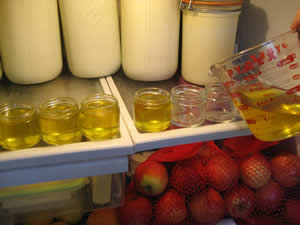 Pour the tallow balm into the containers of your choice... |
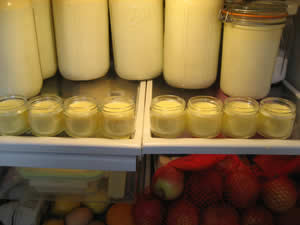 ...and let the tallow balm cool and solidify in the refrigerator. |
Step 6
If desired, you can add essential oils to the liquid mixture as well. We use specific essential oils, such as lavender, that are known for their long-standing tradition of promoting optimal skin health. Another major benefit of using essential oils in your tallow balm is to give it a fresh, pleasant scent and to neutralize the scent of the tallow, which is distinctive although not unpleasant. Since essential oils are extremely concentrated, not much is needed, but care should be taken not to use any that are adulterated, extended, synthesized, or distilled using chemicals or high temperatures and pressure. For this reason, we use therapeutic-grade, genuine essential oils. Again, it is important to know your ingredients and to remember the principle of using only those ingredients that are edible whole foods. You will be able to take pride in the fact that you could take out a spoon and eat this tallow balm since it is a nourishing food for skin and body!
 Traditional nourishing and healing skin care! |
